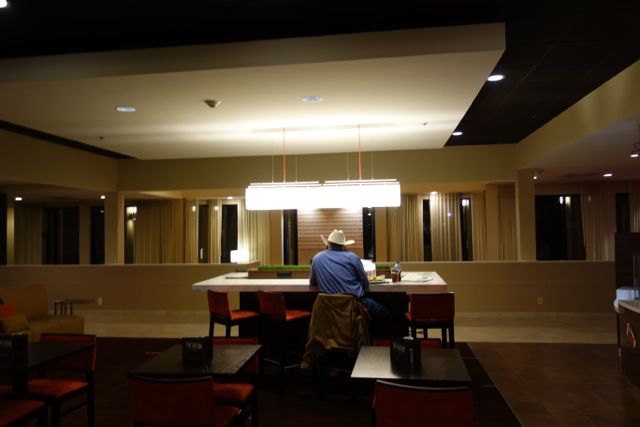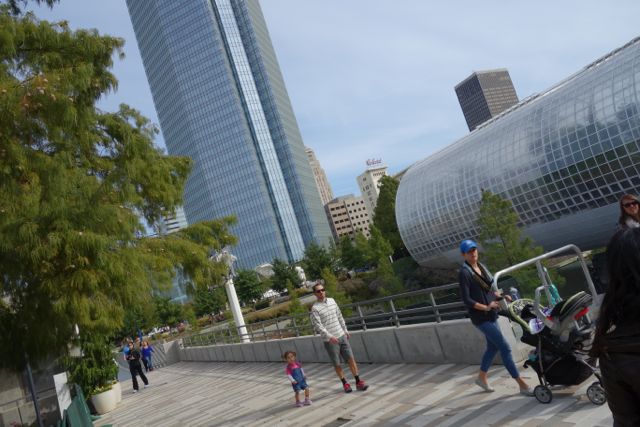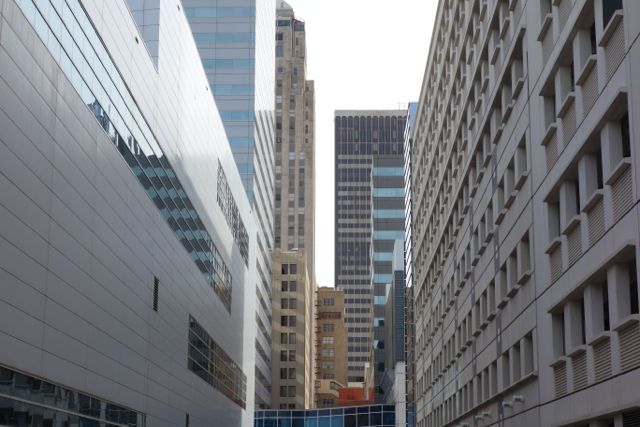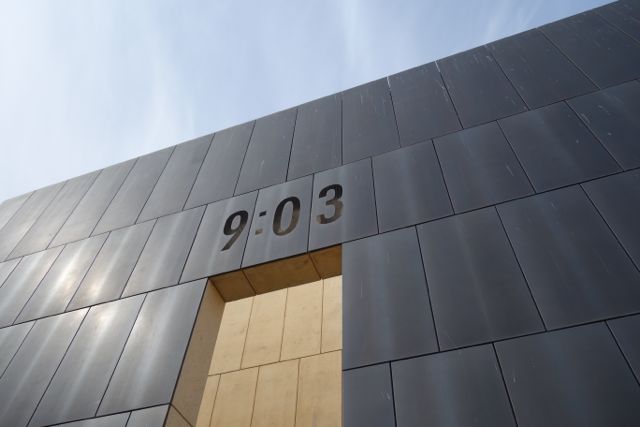
I’d looked forward to our arrival in Oklahoma City, less because I knew anything about it than because it came after an eight-hour, three-state-spanning drive from Albuquerque, through what I mostly remember as a sense-deadeningly repetitive pastoral punctuated by vast fields of windmills. After that, I felt just about ready to settle forever in any place with “City” in its name. But National Geographic Traveler did also name Oklahoma City among the “20 go-now destinations” on its “Best Trips 2015” list, which fueled my suspicions that we’d find something genuinely worthwhile there.

We found, on our first morning, the genuinely worthwhile Myriad Botanical Gardens, an acclaimed (and, coming from California, shockingly bum-free) public space in downtown Oklahoma City just across the street from the Devon Energy Center, the recently built 50-story skyscraper that, so far out of scale with any other nearby structure, pretty much constitutes the skyline by itself. On the opposite side of the gardens, a children’s pumpkin festival had got into full swing, providing perhaps the highest concentration of wholesomeness I’ve ever beheld first-hand. At every intersection, electronic voices offered — and repeated, and repeated — detailed descriptions of which streets we could cross and when. Professional downtown guides zipped by, their canary-yellow uniforms in perfect color coordination with their Segways.

We passed through a few torn-up streets, but they’d been torn up, so the signs informed us, in the name of Project 180, a $176 million pedestrianization scheme, reaching the edge of a neighborhood called MidTown (yes, capitalized T). There we sat down, across the corner from a tempting ramen joint, for a cappuccino, hot chocolate, and “sparkling cold brew” among the bearded baristas, MacBooks Air, and Macklemore haircuts of Elemental Coffee. They’d even put up a stand of tools with which to tune up your bicycle while awaiting your drink (which will sometimes require, as the beards put it, a serious “time investment”). But you won’t have to worry about that if you use Spokies, the city’s bike share system, which has placed one of its stations right in Elemental’s parking lot. Clearly, the center of Oklahoma City, in common with many other greater downtown areas across America (some of which we’ve experienced on this very trip), has a revival going on.

Still, mention the name Oklahoma City to anyone outside it — and surely some inside it — and they think of one thing and one thing only: the 1995 bombing of the Alfred P. Murrah Federal Building. Though only ten years old and in Seattle at the time, I still remember the day it happened, and from then on the disaster, for me as for so many others, stood for the city. I didn’t imagine then that I’d ever have occasion to visit Oklahoma City myself, much less the memorial grounds to be one day built on the Murrah building’s cleared footprint. But there I ultimately went, and there I saw the bronze gates, one representing the minute before the explosion, one representing the minute after. Between them stretches a shallow reflecting pool (dotted, dispiritingly, with pennies), and beside that stand 168 sculptural empty chairs. It ranks high among the massacre sites I’ve seen, lacking either the sinister feeling of Tlatelolco or the whole city of Hiroshima’s faint air of unreality. (The giant weeping Jesus across the street does go a bit far, but a Methodist church built it on their own property.)

On a length of chain-link fence hang stuffed animals (the building’s day care center having infamously absorbed some of the blast and most of the news coverage) and photos of the victims. One studio portrait stood out for its now strikingly retro hair and lighting, and then for the dates below: 1971-1995, 24 years old, hardly more than a girl but not much younger than the bomber himself. The violence of the event haunts me less than the question of how Timothy McVeigh, clearly an intelligent young man of iron resolve and philosophical consistency, somehow arrived, through a seemingly coherent set of principles, at what he saw as the necessary step of car-bombing a federal building. (Incidentally, he did his planning in Kingman, Arizona, where we happened to stop earlier this trip for lunch at a barbecue place called Redneck’s.)

I don’t want to overstate this point, but I’ve spent a great deal of this time behind the wheel trying to understand something more of America, and from that perspective I see McVeigh as not just a “domestic terrorist,” but a thoroughly American terrorist. Brought up on this country’s mythology, more than a few of us entertain the fantasy that we, too, might one day grow into tyrant-toppling outlaw. Many more of us harbor an inherent distrust and even perpetual suspicion of any visible center of power, especially one as colossal as the federal government of the United States: we think of the state as not Us, but Them. McVeigh certainly regarded it as Them, and as malevolent a Them as They come, insisting on describing his act in Oklahoma City as “morally equivalent” to the recklessness of the U.S. government not just at home (he framed his bombing as “counter-attack” in a war initiated by the United States at Ruby Ridge and Waco) and abroad: “Remember Dresden? How about Hanoi? Tripoli? Baghdad? What about the big ones — Hiroshima and Nagasaki?”

Few Americans, I suspect, feel active guilt about the Dresdens, Hanois, Tripolis, Baghdads, Hiroshimas, and Nagasakis of the world, due to a tribally instinctive categorization of the foreigners there, even noncombatants, as Them rather than Us. (I admit to feeling no guilt myself at Hiroshima, less because I regard wartime Japanese as Them than because I regard the Americans who ordered the bombs dropped as an even more alien Them.) McVeigh abandoned that particular concept of Us and Them (to say nothing of “two wrongs don’t make a right”), and so the death of innocents in one place looked as unjustifiable, and so as justifiable, to him as the death of innocents in another — a sentiment with which all 21st-century American liberals would surely agree. For most of us, the less we think in terms of Us and Them, the more humane individuals we become. Timothy McVeigh, on the other hand, became the deadliest mass-murderer in American history.